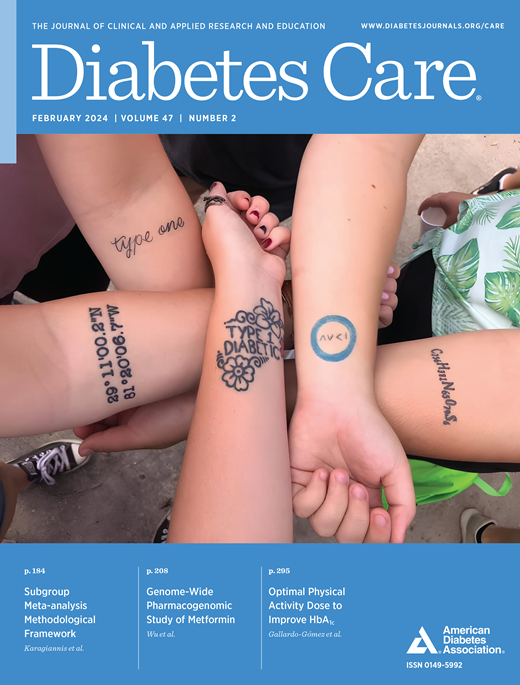Symptoms of Autonomic Nervous System Dysregulation and Diabetes Distress in Adults With Type 1 and Type 2 Diabetes
IF 16.6
1区 医学
Q1 ENDOCRINOLOGY & METABOLISM
引用次数: 0
Abstract
OBJECTIVE To test the association of autonomic nervous system (ANS) dysregulation symptoms and diabetes distress (DD) in adults with type 1 diabetes (T1D; study 1) and type 2 diabetes (T2D; study 2). RESEARCH DESIGN AND METHODS A total of 556 adults with T1D and 299 with T2D completed the Body Perception Questionnaire (BPQ) to assess ANS reactivity symptoms, diabetes distress (via Diabetes Distress Scale T1 [DDS-T1], and DDS-17), anxiety (via General Anxiety Disorder 7 [GAD-7]) scale, depression (via Patient Health Questionnaire-8 [PHQ-8]), and demographic variables via internet surveys. RESULTS In study 1, participants’ mean age was 45.1 (SD 15.7) years and most were female (73.2%) and White (95.3%). The mean self-reported A1c was 6.7% (SD = 1.0%); mean duration of T1D diagnosis 20.6 (SD 14.7) years; and 72.5% of participants reported using an insulin pump. The mean DDS-T1 score was 2.3 (SD 0.8; moderate severity). The BPQ mean T score was 48.9 (SD 8.4) for supradiaphragmatic and 50.6 (SD 8.9) for subdiaphragmatic reactivity subscales. In study 2, participants’ mean age was 60.2 (SD 13.6) years, 58.7% were female, and 82.9% were White. The mean self-reported A1c was 7.0% (SD 1.2%), and 51.8% of participants were treated with oral hypoglycemic agents and 39.9% used oral and injectable medications. The mean duration of T2D diagnosis was 15.0 (SD 10.0) years. The mean DDS-17 score was 2.3 (SD 1.0; moderate severity) and BPQ mean T score was 49.9 (SD 9.4) for supradiaphragmatic and 52.0 (SD 8.8) for subdiaphragmatic reactivity subscales. Controlling for covariates, severity of DDS-T1/DDS-17 significantly predicted elevations in ANS symptom T scores on all subscales (P ≤ 0.05 for all), with “high” DDS having the highest BPQ scores. CONCLUSIONS These findings demonstrate a relationship between ANS reactivity and DDS in T1D and T2D samples.成人1型和2型糖尿病患者自主神经系统失调和糖尿病窘迫的症状
目的探讨成人1型糖尿病(T1D;研究1)和2型糖尿病(T2D;研究设计和方法共556名成年T1D患者和299名T2D患者完成了身体感知问卷(BPQ),通过网络调查评估ANS反应性症状、糖尿病困扰(通过糖尿病困扰量表T1 [DDS-T1]和DDS-17)、焦虑(通过一般焦虑障碍量表7 [GAD-7])、抑郁(通过患者健康问卷-8 [PHQ-8])和人口统计学变量。结果研究1中,参与者平均年龄为45.1岁(SD 15.7),以女性(73.2%)和白人(95.3%)居多。自我报告的平均A1c为6.7% (SD = 1.0%);T1D诊断平均持续时间20.6年(SD 14.7年);72.5%的参与者报告使用胰岛素泵。DDS-T1平均评分为2.3分(SD 0.8;中等严重程度)。膈上反应性量表的BPQ平均T评分为48.9 (SD 8.4),膈下反应性量表的BPQ平均T评分为50.6 (SD 8.9)。研究2中,参与者平均年龄为60.2岁(SD 13.6), 58.7%为女性,82.9%为白人。自我报告的平均A1c为7.0% (SD 1.2%), 51.8%的参与者接受口服降糖药治疗,39.9%的参与者使用口服和注射药物。T2D诊断的平均持续时间为15.0年(SD 10.0)。DDS-17平均评分为2.3分(SD 1.0;膈上反应性量表的BPQ平均T评分为49.9 (SD 9.4),膈下反应性量表的平均T评分为52.0 (SD 8.8)。在控制协变量的情况下,DDS- t1 /DDS-17的严重程度显著预测了ANS症状T评分在所有亚量表上的升高(P≤0.05),“高”DDS的BPQ评分最高。结论:这些发现证明了T1D和T2D样本中ANS反应性与DDS之间的关系。
本文章由计算机程序翻译,如有差异,请以英文原文为准。
求助全文
约1分钟内获得全文
求助全文
来源期刊

Diabetes Care
医学-内分泌学与代谢
CiteScore
27.80
自引率
4.90%
发文量
449
审稿时长
1 months
期刊介绍:
The journal's overarching mission can be captured by the simple word "Care," reflecting its commitment to enhancing patient well-being. Diabetes Care aims to support better patient care by addressing the comprehensive needs of healthcare professionals dedicated to managing diabetes.
Diabetes Care serves as a valuable resource for healthcare practitioners, aiming to advance knowledge, foster research, and improve diabetes management. The journal publishes original research across various categories, including Clinical Care, Education, Nutrition, Psychosocial Research, Epidemiology, Health Services Research, Emerging Treatments and Technologies, Pathophysiology, Complications, and Cardiovascular and Metabolic Risk. Additionally, Diabetes Care features ADA statements, consensus reports, review articles, letters to the editor, and health/medical news, appealing to a diverse audience of physicians, researchers, psychologists, educators, and other healthcare professionals.
 求助内容:
求助内容: 应助结果提醒方式:
应助结果提醒方式:


